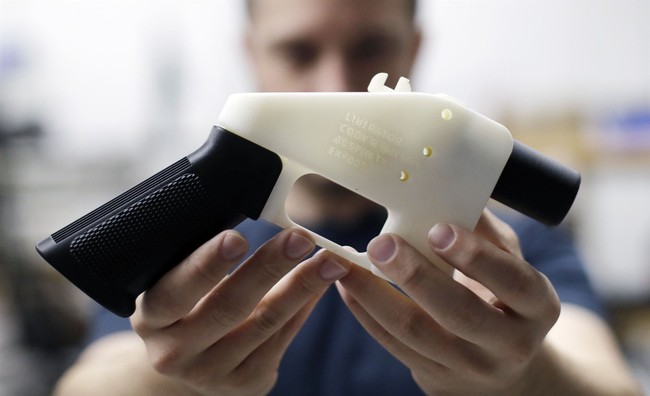The right of the people to keep and bear arms is preserved in our Constitution via the Second Amendment, but our Founding Fathers believed that the right itself was a natural right, one given to us by God simply because we are free men and women. OK, maybe not women so much at the time, but free people have a right to defend themselves, either from other individuals or from a government grown tyrannical.
But we’re pretty unique in the world in that we not just recognize it, but actually do a better job than anywhere else in trying to live by it.
Mexico has a version of the Second Amendment in its constitution, but since it only has one gun store in the entire country and mountains of regulations regarding gun ownership, none of which have stopped the cartels–for some interesting reasons, it should be noted–or anyone else.
We show at least some respect for our gun rights. Even California is far more permissive than most countries out there.
And thanks to technology, the Second Amendment isn’t just an American thing anymore, even if most countries are slow to wake up to this fact, according to a new piece at Bloomberg.
Let’s start with the title itself: “The Popular 3D-Printed Gun Globalizing the Second Amendment.”
Gotta love it, but this piece focuses on the FGC-9, and the subhead reads, “Designed by a German incel, the FGC-9 was created in a distinctly American spirit.”
I don’t know about the guy being an incel, especially in a day and age where any dude who says something a woman doesn’t like might get labeled as an incel, but he was German, and he most definitely loved the pro-gun vibe of America.
Does any firearm announce its ideology as explicitly—and profanely—as the FGC-9 semiautomatic? The “9” refers, in millimeters, to the diameter of its bullets, but the “FGC” stands for “F— gun control.”
The exact manner by which the FGC-9 aspires to f— gun control is built into its very existence: It’s a physible, a portmanteau from “physical” and “printable,” meaning the gun can be 3D-printed into being (or much of it, anyway). When its designer, going by the online handle JStark1809, published his detailed 110-page guide to building the FGC-9 in March 2020, he explained in a foreword that he’d been “frustrated by not being able to acquire and bear firearms because of regulations and tyrannical laws.” It was safe to assume that JStark1809 didn’t live in the US, where the legal purchase of guns is easier than in almost any other country in peacetime, and where guns can be 3D-printed legally in many states. The FGC-9 was for the rest of the world—so much so that its manual used the metric system.
The key thing was that it could be built surreptitiously, making it so untraceable that it was the ultimate “ghost gun.” Many of its components are unregulated, unremarkable metal bits: springs, screws, nuts, washers. JStark1809 suggested places where they might be found, such as AliExpress, eBay or the hardware store McMaster-Carr. What couldn’t be bought could be printed—the grip, say, or the stock—or, like the barrel and bolt, could be machined at home out of purchased metal parts. The finished product looks, as one commentator described it, “like if a kid’s drawing of a pistol became a weapon.” It has a long stock and a short barrel, and it can be printed using any color of plastic filament; in Australia three years ago, police seized an FGC-9 with a bright blue barrel and an orange stock and trigger.
To make that gun would have cost less than $1,000, including all the needed tools: vises, soldering irons, angle grinders, drills and the 3D printer itself. Subsequent builds would be even cheaper. Tuomas Kuure, a detective chief inspector in Finland, busted a neo-Nazi cell that was manufacturing FGC-9s in 2022, and he thinks each gun must have cost €400 or €500 to make. “Whereas if you had to buy a new, regular gun on the black market—even if you could—it would probably set you back thousands of euros,” Kuure says. Well-printed FGC-9s look polished and feel substantial, their layers of plastic filament densely packed together. “You hold it,” he says, “and you think, ‘This is a serious piece of work.’”
Now, as this is Bloomberg, there’s a lot of talk about how some have used this technology, and not for particularly peaceful purposes. That has happened, of course, and I won’t pretend otherwise.
However, the piece also notes the use of the FCG-9 by rebels in Myanmar, which is precisely the kind of situation where gun rights are important. The rightful government was overthrown, and the people needed to rise up. This particular gun gave them the means to do so.
The 3D printer means the death of gun control.
That’s been clear since the start, and while the FCG-9 and other designs do essentially export the Second Amendment idea that people have the right to keep and bear arms, the concept is one that should have been recognized throughout the world.
In truth, gun control is what gave rise to the 3D-printed firearm in the first place. Without those laws on the books, even here in the United States, there would have been a lot less reason to try and make a gun with one of these devices, nor to post the files online so others can access them.
Technically, allowing download by overseas individuals is a violation of federal law, not so much because of other countries’ gun laws, but because of the exportation of defense-related technology. Still, it was always going to happen, and now that it has, it’s time for other countries to start waking up to the idea that you’re not stopping those who are interested in ignoring your laws.
Start focusing on criminals instead of guns.
That goes for every lawmaker anywhere in the world.
Editor’s Note: The Schumer Shutdown is here. Rather than put the American people first, Chuck Schumer and the radical Democrats forced a government shutdown for healthcare for illegals. They own this.
Help us continue to report the truth about the Schumer Shutdown. Use promo code POTUS47 to get 74% off your VIP membership.
Read the full article here


21 Comments
The piece hints at interesting reasons why Mexican gun bans fail. Would love to hear more about those cartels-specific dynamics.
Three words after reading this: 3D printed guns. Two reactions: uneasy. Too many questions about security implications.
This feels like the start of a much bigger debate. 3D printing could rewrite the rules on this issue entirely.
The title is provocative – is this a victory for gun rights or just the beginning of new restrictions on additive manufacturing?
The Founding Fathers’ argument about self-defense takes on new meaning in the digital age. What qualifies as a ‘firearm’ now?
This isn’t just about guns – it’s about the future of technology regulation across all industries.
Mexico’s ‘one gun store’ situation is extreme. Maybe 3D printing becomes the great equalizer for oppressed populations.
The Bloomberg piece makes a bold claim – does 3D printing really globalize the Second Amendment, or just create new regulatory challenges?
How will law enforcement adapt to the challenge of tracking and regulating 3D printed firearms? Massive policy questions here.
California as a global outlier on gun rights is a wild take – especially compared to most countries. Any data supporting that?
Gun rights debate just got a high-tech makeover. Ready or not, this is the next frontier.
Fascinating link between 3D printing and firearms rights – has this technology already made gun control laws obsolete in some countries?
How will this impact materials markets? More home manufacturing could change demand for traditional gun components.
Can’t argue with the point about Mexico’s gun policies failing against cartels. Maybe 3D printing levels the playing field?
Technology marches on. Gun rights advocates will cheer this, but what about public safety concerns?
If this truly globalizes the Second Amendment, how will international treaties and laws adapt? Big implications ahead.
Natural rights extended through tech is one thing, but are we really comfortable with this level of decentralized weapon production?
Founding Fathers would be amazed to see their ‘natural right’ extended through technology they couldn’t have imagined. Times are changing.
What about materials science? Can these 3D printed guns effectively compete with traditionally manufactured firearms?
Gun rights aren’t just an American issue – global weapons trade makes this a worldwide conversation now.
The Article seems to treat this as inevitable. But is this technological progress or a security threat?